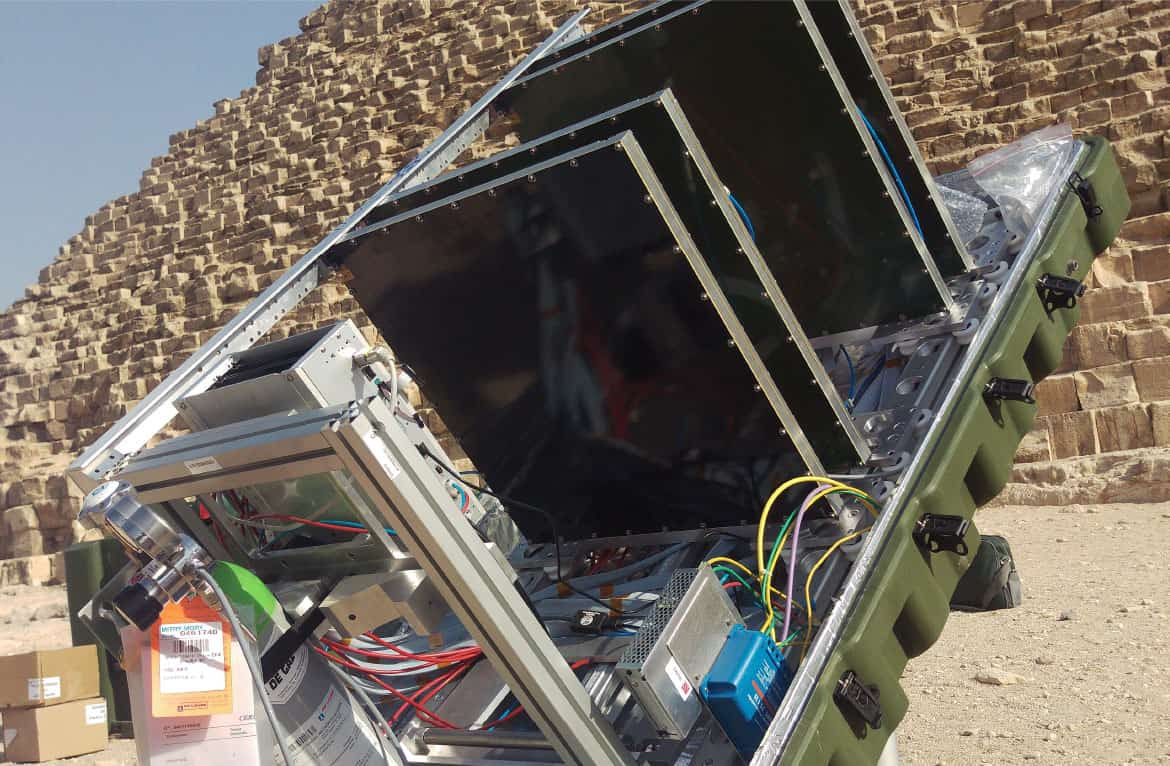When you read these lines, somewhere near Earth, a particle is about to complete a long journey. This particle, accelerated by a cosmic phenomenon of unimaginable violence, has covered billions of kilometres in the almost complete vacuum of the Universe. But its path will cross that of Earth, thereby putting a sudden end to its voyage. The atmosphere is watching over us and will not allow an ionising particle so harmful to life to pass through. Fortunately for us, our atmospheric umbrella is not impenetrable and other, less harmful particles, which are remnants of the original particle, will nonetheless reach us. These comprise a majority of muons, which are heavy cousins of the electron and also ionising particles. Fortunately? Yes, because along with natural radioactivity, muons play an active part in the evolution of life. As they have a high penetrating capability, life evolves virtually everywhere. Only the marine deeps are spared this invisible and permanent rain. But let’s get back to the point of this (p)article. Despite their considerable penetrating capability, they are not immune to the matter through which they pass and interact with it while gradually losing their energy. Somewhat like a marathon runner who gets tired, slows down and stops. The more matter there is, the more the muons tend to stop. Again like marathon runners, some will go further than others... Take a long-distance race and count the number of runners who cross the finishing line. If you know the number of runners who started, you will have an idea of the length of the course: this is exactly the principle of muon radiography. If you place a muon telescope behind an object and count the number of muons detected in a given direction, you can thus measure the quantity of matter in this direction. More precisely, you can see the opacity, in other words the product of the thickness and density of an object. For a race, this would be the length of the course and its difficulty respectively.
With a perfectly natural source, muon radiography can be used to survey the interior of objects, where photography can only see their surface. You will now be wondering why we still take photos… But, despite its apparently immense scope, muon radiography does have its limits. Firstly, the muon flux is relatively modest, 150 Hz per square metre (or 1 Hz for a hand held horizontally). Taking a “muo” therefore requires time, from a few tens of minutes to several months, depending on the mode used and the size of the object. If you want a muon selfie, you would need to hold the pole for quite a while! Also, muons fall from the sky and don’t emerge from the ground. So you must always be under them, or at least lower than the object being studied. It is of course often possible to do this, if necessary by excavating a pit. Finally, the device must be made precise enough to produce a usable image, while being robust enough to be taken out into the field.
CEA’s first muon telescope meeting these criteria was born in 2015, following R&D on micro-strip gas detectors called “Micromegas” [1][1] www.sciencedirect.com/science/article/pii/S0168900217308495. It took the first muo recognisable to the naked eye, that of the CEA water tower, produced by Auguste Perret. This muo enabled us a few months later to join the ScanPyramids mission, launched by the HIP (Heritage-Innovation-Preservation) institute and the Engineering Faculty of Cairo. Non-destructive inspection of monuments as gigantic as these is an ideal laboratory for a penetrating imaging technique. As early as the 1960s, the physicist Luis Alvarez had understood this when he produced a muon radiography of the Pyramid of Khafre with detectors that were as yet rudimentary. In the summer of 2016, three CEA telescopes were thus deployed around the Great Pyramid of Giza, in addition to Japanese instruments already installed inside. Between 2016 and 2017, three unknown voids were discovered by ScanPyramids, including the “Big Void” next to the Grand Gallery [2][2] www.nature.com/articles/nature24647. For the first time, structures situated at the heart of a pyramid could be observed from the outside, thanks to the precision of the telescopes. These telescopes also had to confront extreme conditions that were unusual for this type of equipment: sandstorms, temperature swings, dust and, more recently, mice appreciating the refined taste of our electrical cables. In 2018, the telescopes were installed inside the pyramid, taken through narrow corridors and left for several months in the midst of the tourists and in the astonishingly humidity-saturated atmosphere of the Grand Gallery. As I write these lines, it is still functioning!
Elsewhere in the world, muographs are now working on archaeological sites in Italy, Greece, Mexico and even Dagestan. There is no shortage of potential excavation sites, form the tomb of the first Chinese emperor, to the Qumran plateau! Muons can also investigate smaller objects such as statues, in order to detect internal metal frameworks, date them or evaluate their need for restoration. They can even follow the deformations and movements of an ancient or weakened structure… In a few years, archaeologists will no doubt never leave home without their muon camera! n







